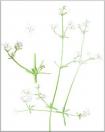Marsh Bedstraw - Galium palustre
Perennial plant up to fifty centimetres tall with thin rhizome and four-edged stem, branched, weak, rough with small down-turned prickles.
Lanceolate leaves, flaccid to the touch, arranged in regularly spaced whorls of 4-6. The median leaves, which are the most developed, reach 15 mm in length.
The terminal or lateral inflorescences consist of many small flowers with a white corolla. It flowers from May to September.
The Marsh bedstraw particularly lives in peaty, temporarily flooded wet meadows, in Sedge beds and round the edges of pools; it can also often be found in the underbrush of European Alder hygrophilous woodlands .
At Lake Sibolla it often grows directly on the mounds of the Sedge beds, together with the Marsh Pennywort Hydrocotyle vulgaris and Milk Parsley Peucedanum palustre.
In Italy it is only found in suitable habitats in the northern regions, Tuscany and the Pontine Marshes; it must be considered a rarity everywhere.
Its Latin names comes from the Greek gala=milk, which refers to the old practice of using another plant of the same genus, Lady's Bedstraw (Galium verum) to set milk in cheese-making.




